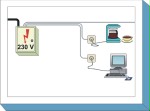S 2.2 Electrical Cabeling

Description
The cabling of IT systems and other devices includes all cables and distributors in the building, from the feed point of the distribution network operator to the terminal points of the consumers.
The proper and standards-compliant installation of the cabling is the basis for secure IT operations. The IT wiring used for communication between the IT systems is addressed in a separate module (see module S 2.12 IT cabling). Since the same routes and trays are often used for both types of wiring, the safeguards mentioned in both modules should be implemented jointly.
Threat scenario
The following typical threats to the IT baseline protection of the cabling are assumed to exist:
Force Majeure
| T 1.6 | Burning cables |
Organisational Shortcomings
| T 2.11 | Insufficient route dimensioning |
| T 2.12 | Insufficient documentation on cabling |
| T 2.13 | Inadequately protected distributors |
Human Error
| T 3.5 | Inadvertent damaging of cables |
| T 3.85 | Impairment of fire protection compartmentalisations |
Technical Failure
| T 4.6 | Voltage fluctuations / overvoltage / undervoltage |
| T 4.62 | Use of inadequate power outlet strips |
| T 4.63 | Dusty ventilators |
Deliberate Acts
| T 5.8 | Manipulation of lines |
Method recommendation
To secure the information system examined, other modules must be implemented in addition to this module, with these modules being selected based on the results of the IT-Grundschutz modelling process.
A host of safeguards must be implemented for the cabling, starting in the planning phase and continuing through the implementation phase to the operation phase. The steps to be followed in this case as well as the safeguards to implement in each phase are listed in the following. Just like for the building, it must be noted in this case as well that the scope of influence when securing the cables is much smaller when moving to an existing building than when constructing a new building.
Planning and design
The basis for high-performance, well-protected cabling is already laid in the planning phase.
Implementation
A major component of fire control is the proper installation of cable channels, which can then be a significant source of risk when not shielded from fire. When installing the cables, detailed and correct documentation must be created since it is almost always very difficult, if not impossible, to determine how a cable was routed or which devices it connects after all cables have been installed.
Operation
The electrical equipment and its usage being inspected regularly forms the basis for safe and trouble-free operation (see S 2.394 Inspection of electrical equipment). When working on cable trays, it must be ensured that the fire safety engineer is involved early on in the planning and execution phases (see S 2.391 Timely provision of information to the fire safety engineer).
Disposal
Electrical cables not needed anymore must also be removed or properly taken out of operation (see S 5.1 Removal or deactivation of unneeded lines).
Contingency Planning
If high availability requirements exist, redundant cables and, if necessary, redundant external connections must be installed.
In the following, the bundle of security measures for the field of "electrical cabling" is presented:
Planning and design
| S 1.3 | (A) | Appropriate segmentation of circuits |
| S 1.20 | (A) | Selection of cable types suited in terms of their physical/mechanical properties |
| S 1.21 | (A) | Sufficient dimensioning of cable trays and channels |
| S 1.22 | (Z) | Physical protection of lines and distributors |
| S 1.25 | (B) | Overvoltage protection |
Implementation
| S 1.9 | (A) | Fire sealing of trays |
| S 1.64 | (A) | Avoidance of electrical ignition sources |
| S 2.19 | (B) | Neutral documentation in distributors |
| S 5.4 | (A) | Documentation and labelling of cables |
| S 5.5 | (A) | Damage-minimising routing of cables |
Operation
| S 2.391 | (B) | Timely provision of information to the fire safety engineer |
| S 2.394 | (B) | Inspection of electrical equipment |
Disposal
| S 5.1 | (A) | Removal or deactivation of unneeded lines |
Contingency Planning
| S 6.18 | (Z) | Provision of redundant lines |

